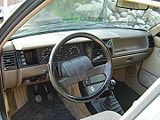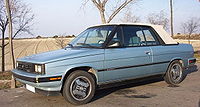Renault 9/11
| Renault | |
|---|---|
|
Renault 9 (1981-1986)
|
|
| 9/11 | |
| Production period: | 1981–1988 (under license until 2003) |
| Class : | Compact class |
| Body versions : | Limousine , station wagon |
| Engines: |
Otto engines : 1.1–1.7 liters (35–88 kW) Diesel engine : 1.6 liters (40 kW) |
| Length: | 3975-4070 mm |
| Width: | 1630-1660 mm |
| Height: | 1400-1410 mm |
| Wheelbase : | 2475-2485 mm |
| Empty weight : | 820-950 kg |
| Previous model | Renault 14 |
| successor | Renault 19 |
The sister models Renault 9 and Renault 11 - R9 and R11 for short - from the French car manufacturer Renault are lower middle class vehicles with a four-cylinder internal combustion engine installed transversely at the front and front-wheel drive .
The R9, introduced in September 1981, is a notchback sedan with four doors. In May 1983, the three- or five-door R11 with hatchback and large tailgate appeared.
history
The Renault 9 and 11 models were developed in collaboration with American Motors Corporation (AMC). Because the vehicles were to be sold in the USA from the start, the series was given the name “Macadam Star”.
The vehicles made in America were called Alliance (R9) and Encore (R11). The Alliance was also offered in the USA as an open, two-door convertible version Convertible, a version that did not come onto the European market.
The chassis included MacPherson struts and wishbones at the front and drawn swing arms (trailing arms) with torsion bars at the rear (there were two versions: with two or four torsion bars).
The front wheel suspension with the steering and the engine and transmission unit sat on a torsion-resistant subframe that was bolted to the front structure with four fastening bolts. The long spring travel of both axles enabled a comfortable, not too tight suspension. The body's side tilt was significantly less than that of the previous R14 model.
The front "swing seats" also contributed to the comfort of the occupants; The angle of inclination of the seat could be changed like a swing and adapted to the needs of the occupants. Along with this special rail construction, the seat length adjustment rails took up almost half of the usual width (called "Monotrace seat"); this allowed the rear seated passengers to place their feet below the front seats to the left and right. With the change to type R19, this solution was dropped in favor of wider seat surfaces.
The basis of the engine was the Cléon Fonte gasoline engine , built since 1962, with 4 cylinders, side camshaft , crankshaft with five bearings , 1108 cm³ displacement and 35 kW (48 hp). Also offered were: Cléon-Fonte with 1237 cm³ and 40 kW (54 PS), 1.4-liter naturally aspirated engines with 44 kW (60 PS) (normal gasoline; later with 50 kW (68 PS), also as "Automatic" - Version) and with 53 kW (72 PS) via the 1.4-l turbo version with 77 kW (105 PS; from autumn 1986 with 85 kW / 115 PS) to the newer F2N / F3N engine type (OHC / with overhead Camshaft and toothed belt drive) as 1.7 l with 60 kW (82 PS; later 66 kW / 90 PS in the last model years) and 69 kW (94 PS) for the GTE. In Germany and Switzerland this engine was available from autumn 1984 with an uncontrolled catalytic converter , electronic manifold injection and an output of 54 kW (73 hp). A 1.6 liter diesel engine of the new F8M engine generation with 41 kW (56 hp) completed the range in autumn 1982.
The supercharged turbo versions that Renault Sport had homologated in the international groups N and A served as the basis for rallying . Renault also developed a prototype with four-wheel steering, but it was never ready for series production.
Facelift
In October 1986, the R9 and R11 were given a facelift , with the front of the vehicle being revised in particular. The characteristic small rectangular double headlights of the R11 of phase 1 gave way to larger, slightly inclined simple headlights, and in the better equipped models such as TXE / GTE wider double-chamber lights. The front indicators were also relocated from the bumper to the headlights (phase 2). There were also darkened rear lights and the relocation of the rear license plate to the bumper. More voluminous, partly also painted bumpers with clear spoiler edges at the front and engine versions with less toxic exhaust gases for various markets such as Germany and Switzerland resulted in increased demand.
A special feature was the Renault Luxmore, which was manufactured by Sanfu Motors in Taiwan . It was a Renault 9 phase 2 with a rear and interior similar to the Renault 19.
The production of the R9 and R11 ended in France and Spain in December 1988 with the switch to the Renault 19 , which was designed by the Italian design office Italdesign . In Argentina , Colombia and Turkey , production was continued in Turkey until 2000 when Renault Broadway . The successor there was the Renault Symbol , the notchback version of the Renault Clio.
Technical specifications
| model | Displacement | Maximum power | Max. Torque | Engine type | 0-100 km / h | V max | Construction year |
|---|---|---|---|---|---|---|---|
| Petrol engines | |||||||
| C, TC, GTC | 1108 cc | 35 kW (48 PS) at 5250 rpm | 80 Nm at 2500 rpm | C1E 715/720 | 21.6 s | 140 km / h | 09 / 1981-05 / 1987 |
| C, TC | 1237 cc | 40 kW (54 PS) at 5250 rpm | 88 Nm at 3000 rpm | C1G 700/710 | 16.0 s | 146 km / h | 09 / 1985-12 / 1988 |
| TL, GTL, TLE | 1397 cc | 44 kW (60 PS) at 5250 rpm | 102 Nm at 3000 rpm | C1J 715 / C2J 730 | 15.7 s | 155 km / h | 12 / 1981-12 / 1988 |
| TL, GTL | 1397 cc | 50 kW (68 PS) at 5250 rpm | 109 Nm at 3000 rpm | C2J 720/766/767/768 | 13.1 s | 160 km / h | 09 / 1985-12 / 1988 |
| Automatic | 1397 cc | 50 kW (68 PS) at 5250 rpm | 109 Nm at 3000 rpm | C2J 718/757 | 153 km / h | 09 / 1981-12 / 1985 | |
| TSE, GTS, Electronic | 1397 cc | 53 kW (72 PS) at 5750 rpm | 106 Nm at 3500 rpm | C2J 717/755 | 13.0 s | 161 km / h | 05 / 1983-12 / 1985 |
| GTX, TXE | 1721 cc | 60 kW (82 PS) at 5000 rpm | 135 Nm at 3250 rpm | F2N 700/704 | 170 km / h | 10 / 1983-12 / 1987 | |
| GTX, TXE | 1721 cc | 66 kW (90 PS) at 5500 rpm | 138 Nm at 3000 rpm | F2N 708/710/798 | 10.7 s | 177 km / h | 10 / 1986-12 / 1988 |
| GTX, TXE 1 | 1721 cc | 54 kW (73 PS) at 5000 rpm | 127 Nm at 2750 rpm | F3N 718 | 10 / 1984-12 / 1988 | ||
| GTE 2 | 1721 cc | 69 kW (94 PS) at 5200 rpm | 143 Nm at 3000 rpm | F3N 708 | 06 / 1987-12 / 1988 | ||
| turbo | 1397 cc | 77 kW (105 PS) at 5500 rpm | 162 Nm at 2500 rpm | C1J 760/764 | 182 km / h | 04 / 1984-10 / 1986 | |
| turbo | 1397 cc | 85 kW (115 PS) 3 at 5750 rpm | 165 Nm at 3000 rpm | C1J 770/782 | 8.5 s | 190 km / h | 10 / 1986-12 / 1988 |
| Diesel engines | |||||||
| TD, GTD, TDE | 1595 cc | 41 kW (56 PS) at 4800 rpm | 100 Nm at 2250 rpm | F8M 700/720/730 | 16.0 s | 146 km / h | 10 / 1982-12 / 1988 |
Special
TSE Electronic was developed from the Renault 11 TSE at the end of 1983 , its 53 kW (72 PS) 1.4-liter engine was equipped with a register carburetor, and from autumn 1984 also in the TXE version with 1.7 liter displacement and 54 kW (73 PS).
It had a numeric control panel and a synthetic voice output that alerted the driver, for example, if the doors were not closed properly, the lights were not switched off after leaving the vehicle or the engine got too hot. An audio hi-fi system (4 × 20 watt output power) from Philips , which could be operated from the steering wheel, completed the extraordinary features of this series. It was the first French car model to be mass-produced with these features. They later became standard in many models, such as the Renault 25 or the Renault Safrane , in which the vehicle communicated using a synthetic voice.
In addition, there were a number of different special models. The Spring (in white) and Spring 2 (in silver-gray metallic) versions were particularly popular . Both were only available in the version revised in autumn 1986.
According to the final report of the Federal Office of Economics and Export Control , 29 Renault 9s were scrapped between January 27, 2009 and July 31, 2010 in favor of the environmental bonus .
Web links
Individual evidence
- ↑ Renault Luxmore: an R9 made in Taiwan! In: carjager.com , June 21, 2016 (French).
- ↑ Final report - environmental bonus. (PDF; 1.6 MB) Federal Office of Economics and Export Control and Federal Motor Transport Authority, November 1, 2010, accessed on July 25, 2014 .











